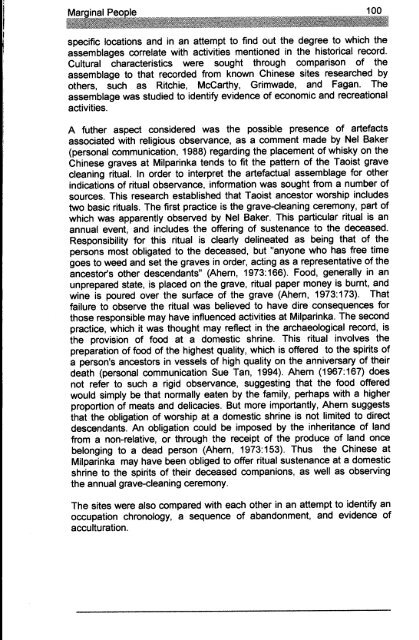Adec Preview Generated PDF File - The Sydney eScholarship ...
Adec Preview Generated PDF File - The Sydney eScholarship ...
Adec Preview Generated PDF File - The Sydney eScholarship ...
Create successful ePaper yourself
Turn your PDF publications into a flip-book with our unique Google optimized e-Paper software.
specific locations and in an attempt to find out the degree to which the<br />
assemblages correlate with activities mentioned in the historical record.<br />
Cultural characteristics were sought through comparison of the<br />
assemblage to that recorded from known Chinese sites researched by<br />
others, such as Ritchie, McCarthy, Grimwade, and Fagan. <strong>The</strong><br />
assemblage was studied to identify evidence of economic and recreational<br />
activities.<br />
A futher aspect considered was the possible presence of artefacts<br />
associated with religious observance, as a comment made by Nel Baker<br />
(personal communication, 1988) regarding the placement of whisky on the<br />
Chinese graves at Milparinka tends to fit the pattern of the Taoist grave<br />
cleaning ritual. In order to interpret the artefactual assemblage for other<br />
indications of ritual observance, information was sought from a number of<br />
sources. This research established that Taoist ancestor worship includes<br />
two basic rituals. <strong>The</strong> first practice is the grave-cleaning ceremony, part of<br />
which was apparently observed by Nel Baker. This particular ritual is an<br />
annual event, and includes the offering of sustenance to the deceased.<br />
Responsibility for this ritual is clearly delineated as being that of the<br />
persons most obligated to the deceased, but "anyone who has free time<br />
goes to weed and set the graves in order, acting as a representative of the<br />
ancestor's other descendants" (Ahern, 1973:166). Food, generally in an<br />
unprepared state, is placed on the grave, ritual paper money is burnt, and<br />
wine is poured over the surface of the grave (Ahern, 1973:173). That<br />
failure to observe the ritual was believed to have dire consequences for<br />
those responsible may have influenced activities at Milparinka. <strong>The</strong> second<br />
practice, which it was thought may reflect in the archaeological record, is<br />
the provision of food at a domestic shrine. This ritual involves the<br />
preparation of food of the highest quality, which is offered to the spirits of<br />
a person's ancestors in vessels of high quality on the anniversary of their<br />
death (personal communication Sue Tan, 1994). Ahern (1967:167) does<br />
not refer to such a rigid observance, suggesting that the food offered<br />
would simply be that normally eaten by the family, perhaps with a higher<br />
proportion of meats and delicacies. But more importantly, Ahern suggests<br />
that the obligation of worship at a domestic shrine is not limited to direct<br />
descendants. An obligation could be imposed by the inheritance of land<br />
from a non-relative, or through the receipt of the produce of land once<br />
belonging to a dead person (Ahern, 1973: 153). Thus the Chinese at<br />
Milparinka may have been obliged to offer ritual sustenance at a domestic<br />
shrine to the spirits of their deceased companions, as well as observing<br />
the annual grave-cleaning ceremony.<br />
<strong>The</strong> sites were also compared with each other in an attempt to identify an<br />
occupation chronology, a sequence of abandonment, and evidence of<br />
acculturation.




